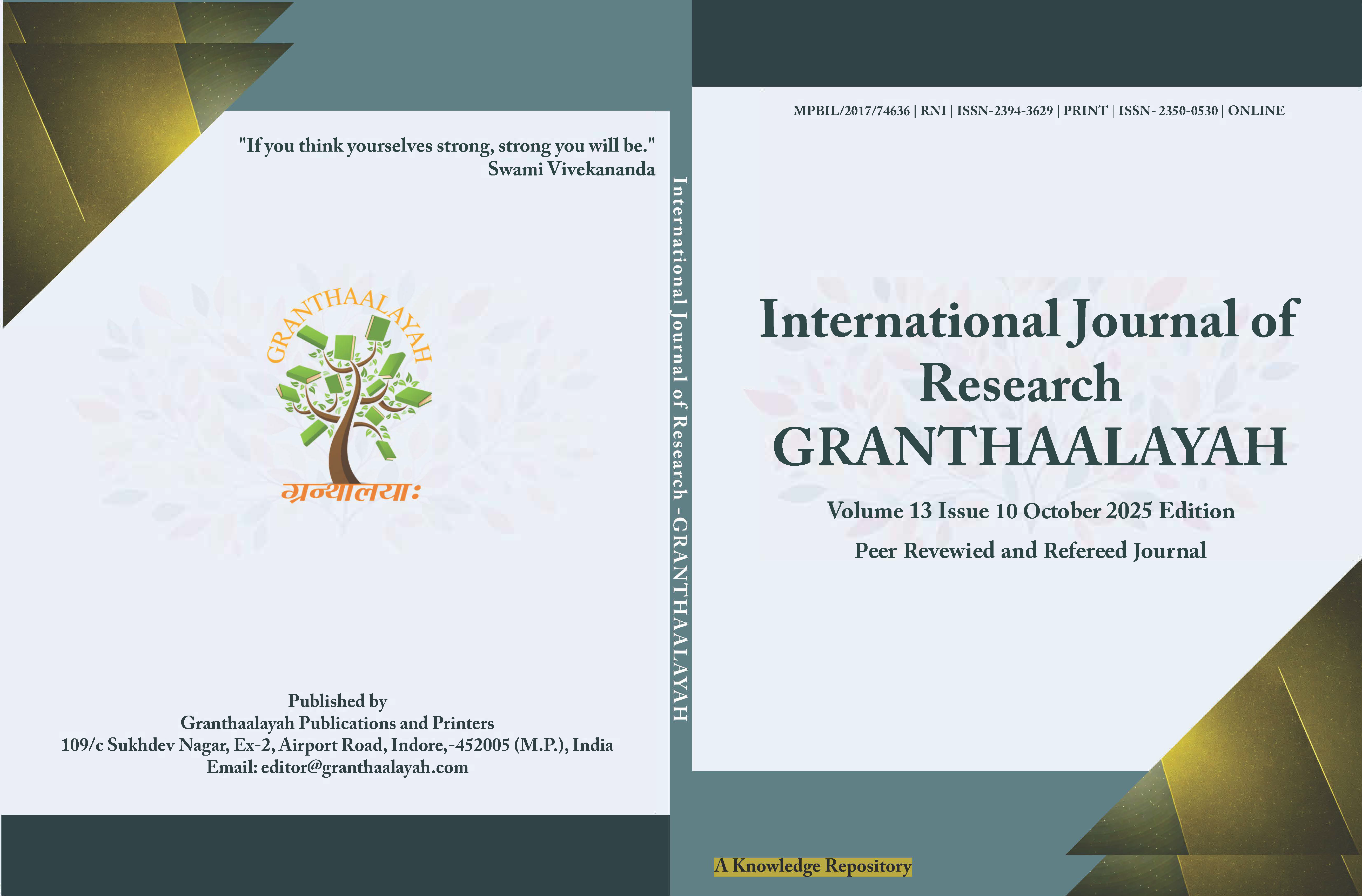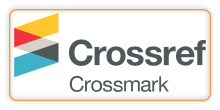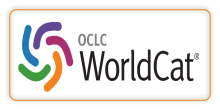WOMEN SELF-HELP GROUPS AS VEHICLES OF SOCIAL ENTREPRENEURSHIP: A PATHWAY TO EMPOWERING MARGINALIZED WOMEN
DOI:
https://doi.org/10.29121/granthaalayah.v13.i10.2025.6382Keywords:
Sustainable Development, Women Empowerment, Self Help Groups, Social EntrpreneurAbstract [English]
The empowerment of marginalized women is increasingly recognized as a critical dimension of sustainable development, particularly in contexts where socio-economic and cultural barriers restrict their access to education, employment, credit, and decision-making. Social entrepreneurship has emerged as a viable strategy to address these challenges, with microfinance-led Self-Help Groups (SHGs) proving especially effective. This study, examines the role of SHGs as grassroots vehicles of social entrepreneurship that combine financial inclusion with social change. Findings highlight that SHG-based microfinance fosters multidimensional empowerment—economic (income generation and financial independence), social (mobility, decision-making, and community participation), and psychological (self-confidence, autonomy, and agency). Evidence from initiatives such as Grameen Bank, SEWA, and Kudumbashree demonstrates how SHGs evolve into social enterprises that enhance household resilience, promote entrepreneurship, and strengthen community solidarity. However, persistent challenges such as patriarchal norms, financial illiteracy, institutional inadequacies, and mission drift limit their transformative potential. The study argues that empowerment through SHGs is not automatic but contingent upon enabling ecosystems, including gender-sensitive frameworks, capacity-building interventions, and supportive policy environments. It concludes that women-led SHGs, when integrated with education, digital literacy, health, and legal awareness, can move beyond financial tools to become engines of social transformation. Thus, SHGs provide a pathway to inclusive development by repositioning marginalized women as leaders and active agents of change.
Downloads
References
Aghion, B. A., & Morduch, J. (2005). The Economics of Microfinance. MIT Press.
Aghion, P., & Morduch, J. (2005). Microfinance: Theory and Evidence. The Annual Review of Economics, 7, 3-35.
Armendáriz, B., & Morduch, J. (2010). The Economics of Microfinance (2nd ed.). MIT Press. https://doi.org/10.1257/app.2.3.60 DOI: https://doi.org/10.1257/app.2.3.60
Baland, J. M., Somanathan, R., & Vandewalle, L. (2011). Microfinance Lifespans: Short-term Impacts and long-Term Sustainability. World Development, 39(6), 1178-1191.
Banerjee, A., Duflo, E., Glennerster, R., & Kinnan, C. (2015). The Miracle of Microfinance? Evidence from a Randomized Evaluation. American Economic Journal: Applied Economics, 7(1), 22-53. https://doi.org/10.1257/app.20130533 DOI: https://doi.org/10.1257/app.20130533
Bateman, M. (2010). Why doesn't Microfinance work? The Destructive Rise of Local Neoliberalism. Zed Books. https://doi.org/10.5040/9781350223974 DOI: https://doi.org/10.5040/9781350223974
Brana, S. (2013). Microcredit: An Answer to the Gender Problem in Funding? Small Business Economics, 40(1), 87-100. https://doi.org/10.1007/s11187-011-9346-3 DOI: https://doi.org/10.1007/s11187-011-9346-3
Brody, C., De Hoop, T., Vojtkova, M., Warnock, R., Dunbar, M., Murthy, P., & Dworkin, S. L. (2017). Can Self-Help Group Programs Improve Women's Empowerment? A Systematic Review. Journal of Development Effectiveness, 9(1), 15-40. https://doi.org/10.1080/19439342.2016.1206607 DOI: https://doi.org/10.1080/19439342.2016.1206607
Chatterjee, P., & Raj, R. (2019). SHGs as an Engine of women's Empowerment. Journal of Rural Development, 38(3), 350-364.
Chatterjee, R., & Raj, R. (2019). Microfinance and Women Empowerment in Rural India: An Impact Analysis. International Journal of Rural Management, 15(2), 221-234.
Cheston, S., & Kuhn, L. (2002). Empowering Women Through Microfinance. UNIFEM.
Chliova, M., Brinckmann, J., & Rosenbusch, N. (2015). Is Microcredit a Blessing for the Poor? A Meta-Analysis Examining Development Outcomes. World Development, 66, 335-353.
D'Espallier, B., Guérin, I., & Mersland, R. (2011). Women and Repayment in Microfinance: A Global Analysis. World Development, 39(5), 758-772. https://doi.org/10.1016/j.worlddev.2010.10.008 DOI: https://doi.org/10.1016/j.worlddev.2010.10.008
Datta, P. B., & Gailey, R. (2012). Empowering Women Through Social Entrepreneurship: Case Study of a Women's Cooperative in India. Entrepreneurship Theory and Practice, 36(3), 569-587. https://doi.org/10.1111/j.1540-6520.2012.00505.x DOI: https://doi.org/10.1111/j.1540-6520.2012.00505.x
Datta, U. (2015). SOcio-Economic Impacts of Self-Help Groups in Rural India. Journal of Development Studies, 51(12), 1602-1617.
Deininger, K., & Liu, Y. (2013). Economic and Social Impacts of an Innovative Self-Help Group Model in India. World Development, 43, 149-163. https://doi.org/10.1016/j.worlddev.2012.09.019 DOI: https://doi.org/10.1016/j.worlddev.2012.09.019
Devika, J., & Thampi, B. V. (2007). Between 'Empowerment' and 'Liberation': The Kudumbashree Initiative in Kerala. Indian Journal of Gender Studies, 14(1), 33-60. https://doi.org/10.1177/097152150601400103 DOI: https://doi.org/10.1177/097152150601400103
Dichter, T. (2007). Hype and Hope: The Illusory Promises of Microfinance. Development in Practice, 17(5), 611-617.
Field, E., Pande, R., & Rigol, N. (2013). Does the Classic Microfinance Model Discourage Entrepreneurship Among the poor? Experimental Evidence from India. American Economic Review: Papers & Proceedings, 103(3), 219-224. https://doi.org/10.1257/aer.103.6.2196 DOI: https://doi.org/10.1257/aer.103.6.2196
Fowler, A. (2000). NGDOs as a Moment in History: Beyond aid to Social Entrepreneurship or Civic Innovation? Third World Quarterly, 21(4), 637-654. https://doi.org/10.1080/713701063 DOI: https://doi.org/10.1080/713701063
Gaiha, R., & Nandhi, M. A. (2007). Microfinance, Self-Help Groups and Empowerment in Maharashtra. Asian Development Review, 24(2), 33-63.
Gertler, P., Levine, D., & Moretti, E. (2011). Do Microfinance Programs Help Families? The Journal of Economic Perspectives, 25(4), 119-139.
Goetz, A. M., & Gupta, R. S. (1996). Who takes the Credit? Gender, Power, and Control Over Loan use in Rural Credit Programs in Bangladesh. World Development, 24(1), 45-63. https://doi.org/10.1016/0305-750X(95)00124-U DOI: https://doi.org/10.1016/0305-750X(95)00124-U
Goetz, A. M., & Jenkins, R. (2018). Feminist Activism and the Politics of Reform: When and why do States Respond to Demands for Gender-Equality Policies? Development and Change, 49(3), 714-734. https://doi.org/10.1111/dech.12389 DOI: https://doi.org/10.1111/dech.12389
Guérin, I., Kumar, S., & Agier, I. (2015). Women's Empowerment: Power to Act or Power over other women? Lessons from Indian microfinance. Oxford Development Studies, 43(4), 523-542.
Harper, M. (2002). Promoting Self-Help Groups: Microfinance and Women's Empowerment. ITDG Publishing.
Hashemi, S. M., Schuler, S. R., & Riley, A. P. (1996). Rural Credit Programs and Women's Empowerment in Bangladesh. World Development, 24(4), 635-653. https://doi.org/10.1016/0305-750X(95)00159-A DOI: https://doi.org/10.1016/0305-750X(95)00159-A
Helms, B. (2006). Access for all: Building Inclusive financial Systems. CGAP, World Bank Publications. https://doi.org/10.1596/978-0-8213-6360-7 DOI: https://doi.org/10.1596/978-0-8213-6360-7
Hermes, N., & Lensink, R. (2011). Microfinance: Its Impact, Outreach, and Sustainability. World Development, 39(6), 875-881. https://doi.org/10.1016/j.worlddev.2009.10.021 DOI: https://doi.org/10.1016/j.worlddev.2009.10.021
Hietalahti, J., & Linden, M. (2006). Socio-Economic Impacts of Microfinance and Repayment Performance: A Case Study of the Small Enterprise Foundation, South Africa. Progress in Development Studies, 6(3), 201-210. https://doi.org/10.1191/1464993406ps138oa DOI: https://doi.org/10.1191/1464993406ps138oa
Hulme, D., & Moore, K. (2006). Why has Microfinance been such a Success? In D. Hulme & K. Moore (Eds.), Development and Social Change: A Global Perspective (76-92). Sage Publications. https://doi.org/10.1057/9780230223073_5 DOI: https://doi.org/10.1057/9780230223073_5
Imai, K. S., Gaiha, R., & Thapa, G. (2012). Microfinance and Poverty-A Macro Perspective. World Development, 40(8), 1675-1689. https://doi.org/10.1016/j.worlddev.2012.04.013 DOI: https://doi.org/10.1016/j.worlddev.2012.04.013
Johnson, S. (2005). Gender Relations, Empowerment and Microcredit: Moving Forward from a Lost Decade. The European Journal of Development Research, 17(2), 224-248. https://doi.org/10.1080/09578810500130831 DOI: https://doi.org/10.1080/09578810500130831
Kabeer, N. (2005). Is Microfinance a 'magic bullet' for women's Empowerment? Development and Change, 36(3), 435-464.
Kabeer, N. (2005). Is Microfinance a Magic Bullet for women's Empowerment? Economic and Political Weekly, 4709-4718.
Karlan, D., & Zinman, J. (2011). Microcredit in Theory and Practice: Using Randomized Credit Scoring for Impact Evaluation. Science, 332(6035), 1278-1284. https://doi.org/10.1126/science.1200138 DOI: https://doi.org/10.1126/science.1200138
Khalid, S., & Yasin, G. (2021). Integrating Social Services with Microfinance: A Sustainable Model for Women's Empowerment. Journal of Development Studies, 57(4), 561-577.
Khalil, F. (2014). Gender, Microfinance, and Empowerment: The Case of Bangladesh. Development and Change, 45(6), 1207-1232.
Labie, M., & Mersland, R. (2011). Corporate Governance Challenges in Microfinance. International Review of Applied Economics, 25(3), 313-326.
Ledgerwood, J. (2013). Microfinance Handbook: A Financial Inclusion Perspective. World Bank Publications. https://doi.org/10.1596/978-0-8213-8927-0 DOI: https://doi.org/10.1596/978-0-8213-8927-0
Mayoux, L. (2001). Tackling the Down Side: Social and Women's Empowerment in Microfinance. Development and Change, 32(3), 579-603. https://doi.org/10.1111/1467-7660.00212 DOI: https://doi.org/10.1111/1467-7660.00212
Mazumder, M. S. U., & Wencong, L. (2013). Microfinance and Women Empowerment: An Empirical Study on Selected Villages of Bangladesh. International Journal of Economics and Finance, 5(5), 126-135.
Mersland, R., & Strøm, R. O. (2010). Microfinance Mission Drift? World Development, 38(1), 28-36. https://doi.org/10.1016/j.worlddev.2009.05.006 DOI: https://doi.org/10.1016/j.worlddev.2009.05.006
Morduch, J. (1999). The Microfinance Promise. Journal of Economic Literature, 37(4), 1569-1614. https://doi.org/10.1257/jel.37.4.1569 DOI: https://doi.org/10.1257/jel.37.4.1569
Morduch, J. (2000). The Microfinance Schism. World Development, 28(4), 617-629. https://doi.org/10.1016/S0305-750X(99)00151-5 DOI: https://doi.org/10.1016/S0305-750X(99)00151-5
Nanda, R. (2014). Microfinance, Women's Empowerment, and Economic Development. Journal of Business Venturing, 29(2), 239-258.
Osmani, S. R. (2007). A Breakthrough in Women's Bargaining Power: The Impact of Microcredit. Journal of International Development, 19(5), 695-716. https://doi.org/10.1002/jid.1356 DOI: https://doi.org/10.1002/jid.1356
Parvin, G. A., Ahsan, S. M. R., & Chowdhury, M. R. (2012). Women Empowerment Performance of Microfinance Institutions in Bangladesh. Research Journal of Finance and Accounting, 3(6), 107-116.
Pitt, M. M., Khandker, S. R., & Cartwright, J. (2006). Empowering Women with Microfinance: Evidence from Bangladesh. Economic Development and Cultural Change, 54(4), 791-831. https://doi.org/10.1086/503580 DOI: https://doi.org/10.1086/503580
Rahman, A. (1999). Micro-Credit Initiatives for Equitable and Sustainable Development: Who pays? World Development, 27(1), 67-82. https://doi.org/10.1016/S0305-750X(98)00105-3 DOI: https://doi.org/10.1016/S0305-750X(98)00105-3
Rhyne, E. (2001). Microfinance: The Next Revolution. Finance & Development, 38(4), 32-35.
Robb, A. M. (2010). Microfinance and Economic Development. Development Policy Review, 28(6), 777-794. https://doi.org/10.1111/j.1467-7679.2010.00510.x DOI: https://doi.org/10.1111/j.1467-7679.2010.00510.x
Robinson, M. S. (2001). The Microfinance Revolution: Sustainable Finance for the Poor. World Bank Publications. https://doi.org/10.1596/0-8213-4524-9 DOI: https://doi.org/10.1596/0-8213-4524-9
Roy, S. (2017). Digital Financial Services and Gender Inequality: Exploring Indian SHGs. Gender & Development, 25(3), 357-372.
Roy, S., & Goswami, K. (2020). Inclusive Entrepreneurship and Social Development: Evidence from Self-Help Groups in India. Journal of Entrepreneurship and Innovation in Emerging Economies, 6(2), 128-146.
Sanyal, P. (2009). From Credit to Collective Action: The Role of Microfinance in Promoting Women's Social Capital and Normative Influence. American Sociological Review, 74(4), 529-550. https://doi.org/10.1177/000312240907400402 DOI: https://doi.org/10.1177/000312240907400402
Schreiner, M. (2001). Informal Finance and the Design of Microfinance. Development in Practice, 11(5), 637-640. https://doi.org/10.1080/09614520120085386 DOI: https://doi.org/10.1080/09614520120085386
Seelos, C., & Mair, J. (2005). Social entrepreneurship: Creating New Business Models to Serve the poor. Business Horizons, 48(3), 241-246. https://doi.org/10.1016/j.bushor.2004.11.006 DOI: https://doi.org/10.1016/j.bushor.2004.11.006
Sharma, S., & Goyal, P. (2018). Role of SHGs in Transforming Rural Women into Entrepreneurs. Indian Journal of Social Work, 79(4), 445-462.
Sharma, S., & Goyal, P. (2018). Social Entrepreneurship and Psychological Empowerment: Exploring the Linkages in Rural India. International Journal of Entrepreneurship and Innovation Management, 22(3), 185-202.
Singh, S., & Dagar, V. (2020). A Study on SHG-Bank Linkage and Women Empowerment. International Journal of Commerce and Management Research, 6(3), 6-12.
Singh, S., & Dagar, V. (2020). Women Entrepreneurship and Microfinance: A Study of Economic and Social Empowerment. Journal of Business and Economic Policy, 7(1), 1-12.
Sinha, S. (2005). Access, use and Contribution of Microfinance in India: Findings from a National Study. Economic and Political Weekly, 40(17), 1714-1720.
Swain, R. B., & Wallentin, F. Y. (2009). Does Microfinance Empower Women? Evidence from Self-Help Groups in India. International Review of Applied Economics, 23(5), 541-556. https://doi.org/10.1080/02692170903007540 DOI: https://doi.org/10.1080/02692170903007540
Thomas, B., & Bhowmick, B. (2022). Social Innovation and Gender Equity Through Micro-Enterprise Development. Asian Journal of Innovation and Policy, 11(1), 55-78.
Woller, G. M. (2002). The Promise and Peril of Microfinance Commercialization. Small Enterprise Development, 13(4), 12-21. https://doi.org/10.3362/0957-1329.2002.042 DOI: https://doi.org/10.3362/0957-1329.2002.042
Woller, G. M., Dunford, C., & Woodworth, W. (1999). Where to Microfinance? International Journal of Social Economics, 26(12), 204-221.
World Bank. (2017). The Global Findex Database 2017: Measuring Financial Inclusion and the Fintech Revolution. Washington, DC: World Bank.
Wright, G. A. N. (2000). Microfinance Systems: Designing Quality Financial Services for the Poor. Zed Books.
Yaron, J., Benjamin, M., & Piprek, G. (1997). Rural Finance: Issues, Design, and best Practices. World Bank Publications.
Yunus, M. (2007). Banker to the Poor: Micro-Lending and the Battle Against World Poverty. PublicAffairs.
Yunus, M. (2007). Creating a World without Poverty: Social Business and the Future of Capitalism. PublicAffairs.
Yunus, M., & Moingeon, B. (2010). Building Social Business Models: Lessons from the Grameen Experience. Long Range Planning, 43(2-3), 307-321. https://doi.org/10.1016/j.lrp.2009.12.005 DOI: https://doi.org/10.1016/j.lrp.2009.12.005
Zehra, M., & Mukherjee, A. (2018). Financial Inclusion and Women's Empowerment in India: An Analytical Study. Journal of Economic and Social Development, 14(2), 89-98.
Zeller, M., & Meyer, R. L. (2002). The Triangle of Microfinance: Financial Sustainability, Outreach, and Impact. International Food Policy Research Institute.
Gerwood, J. (2013). The New Microfinance Handbook: A Financial Market System Perspective. World Bank Publications.
Published
How to Cite
Issue
Section
License
Copyright (c) 2025 Mamatha .N .R, Dr. Cirappa .I .B

This work is licensed under a Creative Commons Attribution 4.0 International License.
With the licence CC-BY, authors retain the copyright, allowing anyone to download, reuse, re-print, modify, distribute, and/or copy their contribution. The work must be properly attributed to its author.
It is not necessary to ask for further permission from the author or journal board.
This journal provides immediate open access to its content on the principle that making research freely available to the public supports a greater global exchange of knowledge.






























